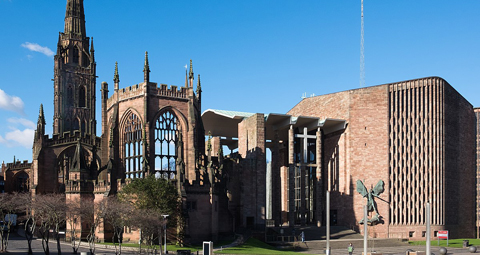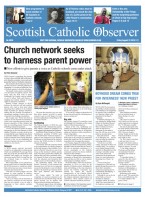April 5 | ![]() 0 COMMENTS
0 COMMENTS ![]() print
print

Ahlfeld’s alternative pilgrimages: Ghost town’s special legacy
In the latest of his series, Ross Ahlfeld revisits a song from his youth and the city of Coventry, whose cathedral has become a beacon of hope and whose history suggests a way forward for many generations to come.
When I was a youngster in the 1980s, there was a belief widely held by various local Mods and Punks that the song Ghost Town by The Specials was about Greenock. Most of the older lads round our way believed this claim to be true.
On reflection, the belief that Ghost Town was written about the small town where you lived, seems to have been a kind of urban legend found among most NME-reading teenagers in many post-industrial towns all across the UK, from Sheffield to Motherwell.
In any case, Ghost Town, with its dark themes of urban decay, unemployment and violence, may as well have been written about Greenock in the years following the closure of the shipyards in the late 1970s.
Jerry Dammers of The Specials describes being inspired to the write the song while on tour, seeing derelict shops being boarded up in Liverpool and women selling their household goods on the streets of Glasgow.
Regardless, what we can say with certainty is that The Specials came from Coventry, a place which also suffered badly from high unemployment and crime towards the end of the 1970s, as the motor industry went into decline.
Coventry Cathedral
With all this in mind (and with The Specials on my iPod) I set off down to spend some time at Coventry Cathedral in reflection and contemplation with a group I belong to called ‘Reconcilers Together.’
This particular meeting was all about gaining an insight into the history and legacy of the cathedral and its reconciliation ministry, as well as learning about the theology and theory behind reconciliation.
As most people know, the medieval Coventry Cathedral was bombed almost to annihilation during the Blitz in 1940.
Today, only the tower, spire, and the outer wall survives, with the words ‘Father Forgive’ inscribed on the wall behind the altar of the ruined building.
Seeing these words reminded me of similar words on a memorial stone in Munster Cathedral in Germany (which was also destroyed during the war), ‘Forgive one another just as God in Christ forgave you.’
‘Christ-child-like world’
Following the bombing of Coventry, Richard Howard, the provost of the ruined building, decided the new cathedral would be at the heart of a movement for peace and reconciliation between all people and faiths.
After the war, Howard offered his vision of what he describes as a more ‘Christ-child-like world,’ with his new cathedral acting as a Centre for Reconciliation.
Certainly, from a Christian perspective, the moment we succumb to the sins of racism and ultra-nationalism, our communion shatters and we scandalise our unity in Christ.
Interestingly, Sabir Zazai, the chief executive of the Scottish Refugee Council based in Glasgow, also holds an affection for Coventry Cathedral.
He describes coming to Coventry from Afghanistan as a young man many years ago and being comforted by the new cathedral as a symbol of hope for communities and individuals trying to rebuild their lives after war.
Generating peace
As such, Coventry is now a major centre for Christian peacemaking theology with the ability to draw people like myself there to study, to learn and to contemplate.
However, for Catholics and especially for us Scottish Catholics, there is so much more connecting us to Coventry hidden under the surface.
For example, St Mary’s Guildhall in Coventry is the finest medieval guildhall in Britain and was once used as a prison for our own Mary Queen of Scots. Similarly, close by the guildhall is St John’s which was also built by the Religious Guilds in 1344.
During the Civil War, this Church was also used as a prison for Scottish Royalists, giving rise to the saying, ‘Sent to Coventry.’
In Coventry during the Middle Ages, the powerful Holy Trinity Guild dominated the city, which had a high concentration of craft skills.
Trades ranged from weaving to soap-making and there was an equally beautiful Guild Chapel not too far away in nearby Stratford.
It’s also worth noting that Coventry City FC is another of those English clubs formed from a works team (the club was established by workers at the Singer cycle factory in 1883) with a sizeable Scottish contingent throughout its entire history.
Indeed, the Sky Blues could easily manage to field a reasonably impressive Scottish 11, with notable Scots such as Tommy Hutchison, Gordon Strachan, Gary Gillespie, Kevin Gallacher, David Speedie and Gary McAllister, all having pulled on the famous blue and white jersey at one time.
Middle ages
Yet, you might well ask why are the aforementioned religious guilds and guildhalls so important and how might they relate to our Catholic Faith and social teaching today?
Guilds began in the Middle Ages as way for craftsmen to protect their common interests and as such, they are often thought to be the precursors of modern trade unions.
These associations of artisans had the right to control their own craft in each town.
London had more than 100 guilds referred to as livery companies, many of which still survive today.
Some economists and historians believe that the guilds helped to develop communities which were (in a primitive sense) both cooperative and self-managed.
Other critics describe these ancient associations as being small groups of self-serving and protectionist cartels.
But recent research on the guild system shows that medieval England was much more prosperous than previously thought. It seems that the guilds boasted an average income that would be more than double the average per capita income of the world’s poorest nations today.
Inspiration
Indeed, in the late 19th and early 20th centuries, thinkers such as John Ruskin, William Morris and GDH Cole began to look back at the guild system for inspiration.
In 1871 Ruskin created the Guild of St George, which aimed to oppose the human misery caused by industrialisation.
John Ruskin also sought to imbue society with a Christian ethos where the social good would be superior to individual greed. Interestingly, the Guild of St George actually still exists today and continues its good works.
GHD Cole took things even further by developing Guild Socialism as an economic alternative to the dehumanising materialism of both state and market.
Cole visualised autonomous, worker-owned guilds based on cooperative principles.
‘Self-help’
And from this system of ‘self-help’ he imagined a return to a more collaborative society based on quality, sustainability, social equality and decentralisation.
Cole can perhaps be described as being against both communism and capitalism in that he imagined a society without large powerful and uncontrollable bureaucratic structures that destroy the very possibility of social equality and democratic participation for everyone.
The Church also favoured this model for society: Pope Pius XI in his 1931 encyclical Quadragesimo Anno calls for local ‘subordinate groups to manage business and concerns of lesser importance,’ so that the state might ‘freely and effectively do all those things which belong to it alone.’
Pope Pius XI then goes on to describe a social policy which should devote itself to the re-establishment of locally managed industries and professions.
Indeed, in Catholic social teaching, associations which practise the same trade or profession with powers of self-government are thought essential to civil society.
Even so, it would be incorrect to think that any notions of radical self-organised workplaces have now been consigned to the long forgotten medieval period or Victorian era.
All about the women
38 years ago in February, the women of the Lee Jeans factory in Greenock staged a seven-month work-in until the owners reversed their decision to close the factory and agreed to a buyout.
By all accounts, the factory was run efficiently, profitably and fairly during the period of workers’ control. It remains, for me, one of the great moments in our long social history.
At the time, the women were visited by many Labour and trade union worthies such as Jimmy Reid, Mick McGahey, Tony Benn and Michael Foot but it was really all about the women.
So, perhaps we might reconsider some aspects of obscure Christian-based economic models such as guild socialism, an ethical model which sought to preserve the full human dignity of everyone. One of the problems with modernism is the assumption that everything in the past was bad or wrong.
Maybe we might look again at former ways of ordering our communities and workplaces which could potentially better insulate us against the ever-looming return to recession and the dreary bad old days which inspired the song Ghost Town, reducing places like Glasgow and Coventry to shadows of their former selves.
Just as Ruskin and Morris could visualise meaningful work and beauty emerging from the misery of industrialisation and mechanisation, equally Christian peacemakers like Dick Sheppard and Richard Howard also built up their own vision of Christian peace and reconciliation from the rubble and ruins of Coventry Cathedral.
These days we’d do very well to pray for reconciliation between Scotland and England, Catholics and Protestants, and Leavers and Remainers.
In the end, it’s easy to dismiss such figures as eccentric dreamers and romantics, yet peacemakers and Utopian thinkers are simply creative people who can see the world as being as beautiful as it should be, or, in other words, humanity imbued with Christian hope, thirsting for the Kingdom of Heaven.










